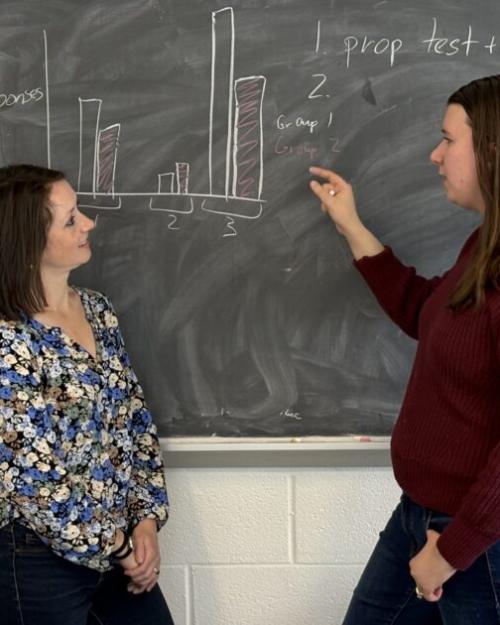

 Department Homepage
The College of Arts & Sciences
Department Homepage
The College of Arts & Sciences
Multidisciplinary
Cornell University has always understood that the world does not apportion neatly into one discipline or another. That may be why Cornell, an Ivy League university where the pursuit of new knowledge is given free rein, has initiated many areas of multidisciplinary research. Yes, there are departments and faculties with familiar names at Cornell, but the walls between disciplines are so low that you can move easily in all directions.
Broad
If multidisciplinary collaboration is one attribute of Cornell’s graduate program in physics, the breadth of its curriculum and faculty is another. Of the nation’s best-regarded physics departments, Cornell is comfortably mid-sized. The faculty is comprised of more than 40 active professors, plus 20 emeritus professors (many of whom remain active in research), and half a dozen adjunct professors. Faculty members advise approximately 65 post-docs and research associates and 180 graduate students-with, on average, 30 new graduate students entering each year.
Congenial
Given its stature, the physics department at Cornell surprises many people by its low-key congeniality. It is the sort of place where people talk to one another in the halls. Among graduate students, relationships are more cooperative than competitive. Graduate students play intramural sports together, go to ballroom dancing classes and form musical ensembles. As one prospective student recently said to his Cornell hosts, “You can’t be graduate students. You all seem far too happy.”
Superb Facilities
The strength of the Physics Department is complemented by major research facilities. Graduate students who want to learn to make use of these facilities will find willing mentors among faculty members, research associates, technicians and other staff members. By expressing an interest, a graduate student can learn to take apart and rebuild a particle accelerator, produce highest-quality images on a tunneling electron microscope, or fabricate a silicon chip that will be a substrate for growing nerve cells.
The program is designed for the student who wants to become a professional physicist. It has two main components:
Mastery of at least a core of advanced general physics. This component is intended to provide the students with the foundational knowledge enabling them to pursue a broad range of employment options upon graduation, including teaching physics at a four-year college level or higher, and/or conducting research in areas different than that of the thesis.
Original research in a specific area of physics. The research component provides the student with an in-depth knowledge of a particular area of active physics research, along with significant research experience in that area culminating in production of a thesis based on original scientific findings.
First Year
Most students begin the program by taking Core Courses, while also being funded as Teaching Assistants. The advising seminar, PHYS 7685, is offered in the fall semester to help new students integrate into the program and learn about physics research at Cornell. The Qualifying exam is taken at the beginning of the student’s 2nd semester at Cornell. Students should start actively looking for a research group in their first year, and should plan on spending the summer after the first year on campus, either doing research full-time or pursuing reading projects directed by a faculty member.
Second Year
Second-year students generally split their time between taking advanced courses relevant to their chosen research field, and doing research. The time spent on each activity may vary widely depending on the area of specialization. By the end of the second year, the student should identify the faculty member who will supervise the thesis, i.e. serve as the Ph.D. advisor. The mutual commitment between the student and the advisor is formalized by the formation of the permanent special committee.
Third - Sixth Year
Beyond the second year, student’s efforts are primarily directed towards research, and the thesis advisor serves as the main source of guidance. The A-exam (Advancement to Candidacy) is taken in the third year, and is devoted to subjects in the area of the proposed thesis topic. After a sufficient body of original research results has been produced, the student prepares a thesis, which is approved by the advisor and the permanent special committee. Finally, the student takes the B-exam, also known as “Thesis Defense”, and completes the program. The typical time spent in the program is about six years.
Note on Ph.D. and M.S. Degrees
Students admitted to graduate study in physics at Cornell are enrolled in the Doctoral program. There is no Master’s program in Physics. Most students are awarded a Master’s degree at the time of advancement to candidacy, as an in-progress degree.
Click here for descriptions of research facilities available to physics graduate students.
Click here for a schedule of research group meetings.
Professor Matthias Liepe
302 Physical Sciences Building
Professor Liepe can assist with policy questions, advice about interacting with faculty, difficulties in the program, help to resolve research group or committee issues, and graduate student stressors.
Ellen Quarmby - Interim
109 Clark Hall
Ellen can assist with graduate admissions, recruitment, prospective graduate visit weekend, and new graduate student orientation. She can also assist with graduate program milestone requirements, scheduling exams, Graduate School forms, questions about committee changes, applying for a leave of absence or in absentia, fellowships awards, obtaining the DGS signature and making an appointment with the DGS.